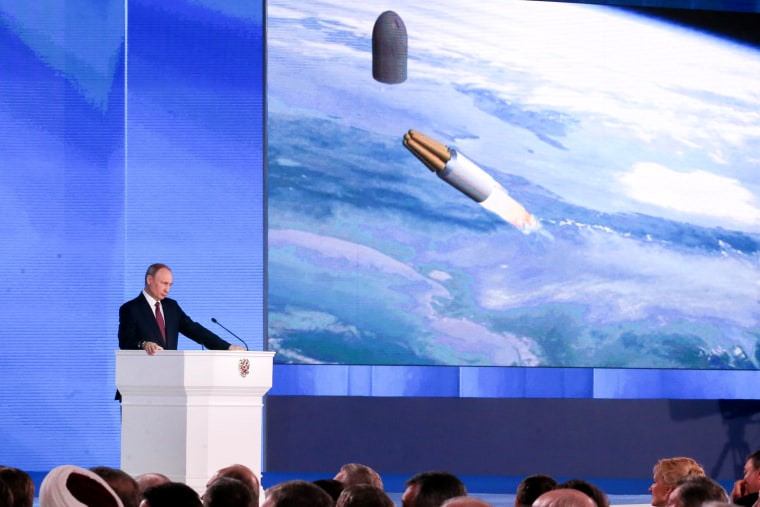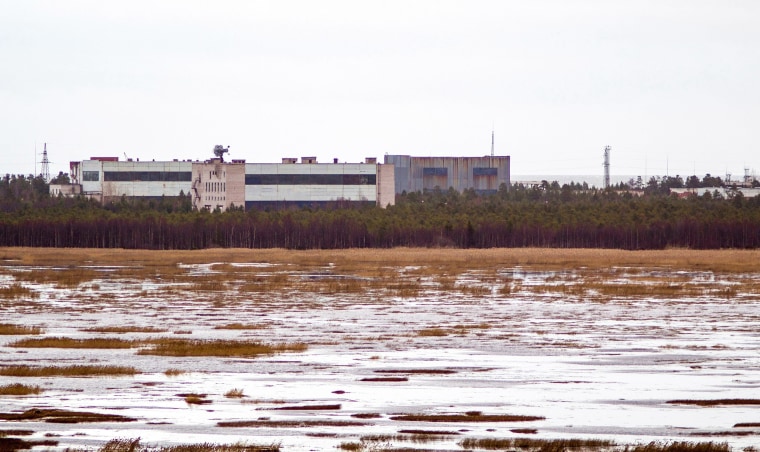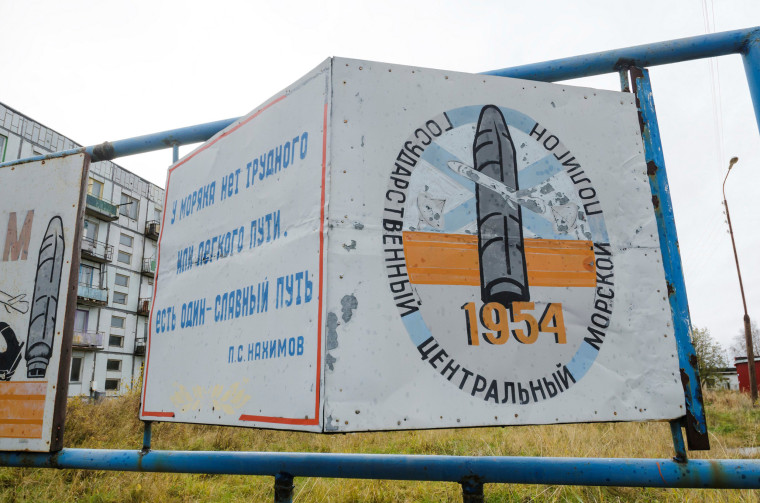A recent explosion during what experts say was likely a Russian nuclear-powered missile test indicates Moscow could be pursuing dangerous technology in an attempt to beat U.S. missile defenses.
Five scientists were killed and radiation spiked in a nearby city following the blast at an offshore platform in the Russian Arctic last Thursday.
Authorities have drip-fed details of the incident to the public. But Monday, Vyacheslav Solovyov, scientific director of the Russian Federal Nuclear Center, confirmed that at the time of the blast, nuclear scientists at the Nyonoksa military range were working on "small-sized energy sources using radioactive fissile materials."
Another factual morsel came when Russia's state nuclear agency, Rosatom, said the accident happened while testing "isotope power sources within a liquid propulsion system."
Experts said this vague, technical wording hinted that the facility was likely testing the same experimental weapon Russian President Vladimir Putin announced in March 2018. He revealed that Russia was developing a cruise missile with "unlimited range" that could carry a nuclear weapon to any point on the globe.

The incident drew a response from President Donald Trump on Monday night, with the president tweeting that it "has people worried about the air around the facility, and far beyond. Not good!"
Experts say all the evidence points toward it being a test of the rocket that Putin announced.
"There's really no other possible scenario for this. All the pieces fit together," said Vipin Narang, a politics professor at the Massachusetts Institute of Technology who focuses on nuclear weapons. "It's very difficult to imagine that it's anything else besides this."
The deadly explosion came days after the United States scrapped the Intermediate Nuclear Forces Treaty, complaining Russia had violated the pact banning ground-based nuclear weapons of a certain range. The New Strategic Arms Reduction Treaty, which limits long-range nuclear weapons, is set to expire in February 2021 unless renewed.
"We're kind of stumbling or drifting into this arms race with the Russians," said Jeffrey Lewis, a nuclear expert at the James Martin Center for Nonproliferation Studies at the Middlebury Institute of International Studies.
"But there is a real human cost to an arms race," he said. "There were all kinds of disasters in the Soviet Union and the United States during the Cold War, because people felt so strongly about the need to do these dangerous things."
Russia's defense ministry initially said two people had been killed, before Rosatom announced the death of five of its scientists. It was not clear what the final death toll was.

The weapon likely being tested last week according to Lewis, Narang and other experts, is called the Burevestnik, which translates as "petrel," a type of sea bird. NATO has dubbed it the SSC-X-9 Skyfall. If completed, the missile would not only be nuclear-armed but also nuclear powered, carrying a relatively small reactor to heat the air in its jet engine.
It would fly at a lower and on a less predictable trajectory than an intercontinental ballistic missile, making it theoretically capable of evading U.S. missile defenses.
"You can see how the missile bypasses interceptors," Putin said last year alongside a computer-generated video of the rocket. "As the range is unlimited, the missile can maneuver for as long as necessary."
"As you no doubt understand, no other country has developed anything like this,” he added. “There will be something similar one day but by that time, our guys will have come up with something even better."
Trump claimed on Twitter that the U.S. has "similar, though more advanced, technology."
It was not immediately clear which weapons the president was referring to. The U.S. did try to develop a nuclear-powered cruise missile in the 1960s but Project Pluto, as it was called, was scrapped because it was considered too dangerous.
Joe Cirincione, president of the anti-nuclear weapons group the Ploughshares Fund, said that the president's tweet was "bizarre" given that the U.S. does "not have a nuclear-powered cruise missile program."
Little is known about the Russian version, but experts — many of whom were horrified at Putin's announcement last year — say it will likely run into many of the same grave safety concerns.
"Think of it like a mini Chernobyl on a missile," MIT's Narang said. "It's an air-breathing cruise missile and they put an unshielded mini nuclear reactor on it. Obviously, that's pretty bats--- insane. We tried this in the 1960s and gave up for a reason, and this is why. It's very risky."
Thursday's accident is the latest sign that Russia's attempts to succeed where the U.S. failed are not going to plan. This is the latest of several failed tests since they started in 2017.
Cheryl Rofer, a retired chemist at the Los Alamos National Laboratory, the birthplace of the atomic bomb in New Mexico, believes Putin will never succeed.
"There are basic and fundamental engineering considerations that suggest that a nuclear-powered cruise missile with a very small power source will be very difficult or impossible to build," she wrote on the Nuclear Diner website Sunday.
That's because of how difficult it is to make this type of missile light enough but with enough power to fly. But the main reason it was abandoned in the past is the design has the potential to spread radioactive particles over the ground as it flies. In the 1960s, the U.S. did not want to test its rocket in Nevada or over the Pacific because of the risk it could veer off course and cause an environmental catastrophe.
"Is it dangerous? Yes!" Lewis said. "I think the phrase 'flying nuclear reactor' tells you all you need to know. You've got air blowing through an open nuclear reactor and spewing out the back."

In his announcement last year, Putin made no secret of why he's so intent on reviving a technology that has been discredited by scientists for decades as dangerous and irresponsible. He sees it as the necessary weapon to beat potential advances in U.S. missile defenses.
Many scientists are deeply skeptical of the effectiveness of domestic missile defenses based in Alaska and California. This is because incoming missiles can deploy countermeasures such as decoys or systems that cool their temperature so they're all but invisible to interceptors.
But Russia is developing the Skyfall on the assumption these defenses will improve, according to Narang.
"I would not count on our national missile defenses to intercept even a single incoming North Korean [intercontinental ballistic missiles] right now," he said. "But what worries Russia is not necessarily it working today, but working in the future."
He added that "the fact that the Russians have lost lives and made real sacrifices testing this missile shows just how terrified they are of U.S. missile defense."
Lewis, at the Middlebury Institute of International Studies, broadly agrees: "The Russians take missile defense extremely seriously, much more than we are willing to admit the United States."
"However, it takes a special kind of crazy to do this. What most countries would do would be just build more nuclear weapons because it's cheaper," he added. "Instead the Russians seem to have gone down this Soviet path of this kind of bizarre menagerie of doomsday weapons."
